
In this Italian basilica in Rome, no less than 6 popes are buried, along with other significant personalities. It’s not situated inside the Vatican, but just like an embassy it is considered papal territory. It is one of the 4 churches that has the title of papal Basilica in Rome, along with: Saint Peter’s, the […]

As a Christian, I failed to sense the spiritual power of this place, but the impression of force and artistic achievement is overwhelming. Probably because Saint Peter’s Basilica is rather a museum, than a place of worship. It is the largest interior space any church has on the face of the Earth. And is the […]
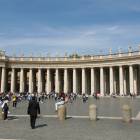
The most important church of the Catholic world, Saint Peter’s Basilica in Rome, had to have a public square in front from which to be admired, to match its greatness. Though the curtain-like facade still blocks most of the height of the main dome, which can only be seen properly from a far, Piazza San […]

„Thou art Peter, and upon this rock I will build My church; and the gates of hell shall not prevail against it.” (Matthew 16:18) With these famous words, Jesus Christ instituted the Christian Church, changing the name of Simon to Peter (meaning rock in Latin) to mark the new life of the first disciple that […]

This is the best preserved Roman building in Italy’s capital, used almost without interruption since 123 AD, when emperor Hadrian commissioned it as a personal tomb. Very short after, the beautiful bridge over Tiber was built. It connects the mausoleum with the center of Rome, and also offers an easy access from the city to […]
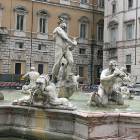
Part of the beauty of Rome is that every street corner can turn into a museum. The public squares are places that unite locals and tourists, remembering the rich history of the city. For example, Plaza Navona, is not the most famous, nor the most romantic, but is very representative for what Rome is. Predictably, […]
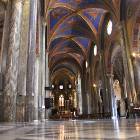
You would not be able to tell it has a Gothic structure on the inside, from the unsuspecting, modest Baroque facade. That is a later addition and its flat low height wall only makes the church blend in with the rest of the buildings on the street. On the inside, the height of the church […]
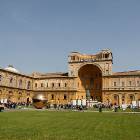
The Papal residence is not a palace in the traditional understanding of the term, but rather a collection of villas, palaces and other interconnecting buildings, constructed in different centuries. The oldest, the Belvedere, dates from 1484. At that time it was the first major villa built in Rome not out of necessity, but for the […]

Pieta is probably the second best known statue of Michelangelo. Without reaching the absolute perfection of David, found in Florence, this sculpture is an impressive example of Renaissance art, by what is probably the best sculptor since antiquity. It represents Mary holding the lifeless body of Jesus, after the descent from the cross, a theme […]

From the treasury held by the Vatican Museum, some 460 notable paintings, grouped in 18 chambers, were selected to form Vatican’s art gallery open to the public. Among them, the works of Raphael, Leonardo da Vinci, Titian, Giotto, Veronese, Caravaggio and many others. The canvas paintings add to Michelangelo’s frescoes in the Sistine Chapel and […]
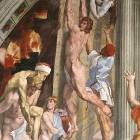
What Medici family started in Florence, and was branded by their chronicler and propagandist Giorgio Vasari as the Renaissance, found its peak in Rome, with the help of Pope Julius II. Perhaps the name chosen by this pope, alluding to Julius Caesar, was not coincidental. The ambitions of this head of the Catholic Church ran […]

The last supper Jesus and His apostles took before the trial and the crucifixion is one of the most popular scenes in Christian iconography. The tradition is so old, this scene was even drawn on the walls of the catacombs when Christianity was illegal. The biblical foundation of this art motif is the highly significant […]

One of the richest art collections in the world, the Vatican Museum has an entire section dedicated to animal sculptures (Sala degli animali). Displayed here are creations from antiquity to renaissance, some proving impressive artistic qualities especially in reproducing body movement, muscles and tension. Painstakingly details, like the hair in lion’s mane or the fur […]

Three emperors contributed to this public bath, the most grandiose building of its type. Its 120.000 sq m size equaled the prior baths of Caracalla, but it included some architectural innovations especially about arcades and semi-domes that were to be used in churches and public buildings for the millenniums to come. The Roman baths were […]
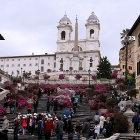
For anyone who visits Rome, Plazza di Spagna is one of the loveliest places to be in, and it would be a very romantic scenery if only another million people wouldn’t have had the same urge at the same time. As it is the case with Fontana di Trevi, Scalinata is a perfect place to […]
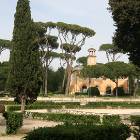
The Pincian Hill may not be one of the famous seven hills of ancient Rome, but today is the most pleasant one, as it hosts the finest park in the city. To imagine a person as rich and powerful as to have something like that as a week-end domain is enough to give us head-spins. […]

Though it is a recent work, the Anglican Church on Via Nazionale in Rome was included on the Italian national monuments’ list, thanks to the work of three artists, two English and one American. The mosaics they created manage to give the church of St Paul’s Within Walls the convincing appearance of a centuries old […]
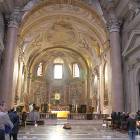
This church, found in Piazza de la Repubblica, was incorporated into the baths of Diocletian by two great architects. The first one was Michelangelo Buonarroti and the second one was Luigi Vanvitelli, the architect of Caserta Palace, near Naples. So the entrance of the church maintains the unsuspected shape of a ruin wall from an […]
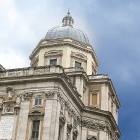
When people hear “the cathedral of Rome” usually think of St Peter’s Basilica in the Vatican, from where the Pope delivers the Easter benediction. Well, in fact St Peter’s is not a cathedral at all, it’s a “regular” church, despite its architectural and historical value. The term cathedral comes from the Latin word for seat, […]

Palazzo Braschi was built in the 18 century by the duke Luigi Braschi Onesti. Under the Napoleonic occupation of Rome, duke Braschi was declared mayor of the city. Donated to the Italian state, the palace was used by Benito Mussolini as his headquarters. The most important architectural piece of the palace is the monumental marble […]
- Home Page
start page - Architecture
landmark buildings - Sacred architecture
places of worship - Nature
landscape photography - Concert
performing artists - Christmas
Santa Claus pictures
- Jooble
jobs for photographers - Escape
an out of control blog - Merry Christmas
The best organizer of Christmas parties - Astro photo
Eclipse hunting and astrological photography

